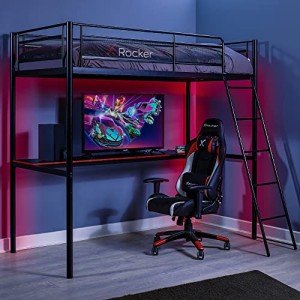11 “Faux Pas” Which Are Actually OK To Make With Your Bunk Beds
Exploring Bunk Beds: A Comprehensive Guide
Bunk beds have actually long been a staple in children's bed rooms, dormitories, and even homes with minimal space. Not just do they provide a practical sleeping option, however they likewise develop an enjoyable and imaginative environment for children and a great space-saver for adults and households. This post will explore whatever you require to learn about bunk beds, from types and products to security ideas and buying guidance.
Table of Contents
- Types of Bunk Beds
- Conventional Bunk Beds
- Loft Beds
- Triple Bunk Beds
- L-Shaped Bunk Beds
- Material Options
- Wood
- Metal
- Safety Considerations
- Purchasing Guide
- FAQs
Kinds Of Bunk Beds
Bunk beds can be found in different styles to fit different needs and preferences. Here's a breakdown of the most typical types:
Conventional Bunk Beds
Traditional bunks typically feature two beds stacked vertically on top of one another. These beds are perfect for brother or sisters sharing a space or for optimizing sleeping space in visitor rooms.
Loft Beds
Loft beds stand similarly to traditional bunk beds but do not have a lower sleeping area. Instead, they typically include a desk or seating location underneath, making them a great option for little rooms requiring multifunctionality.
Triple Bunk Beds
Triple bunk beds are developed for 3 occupants, with beds stacked in a three-tier setup. Yuvraj Vargas are less typical however can be an enjoyable option for big families or pajama parties.
L-Shaped Bunk Beds
With one bed positioned horizontally and the other vertically, L-shaped bunk beds are frequently geared up with extra functions such as desks or storage drawers and can complement corner spaces in a room.
Contrast of Bunk Bed Types
Bed Type
Ideal Use
Description
Conventional
Shared bed rooms or visitor spaces
2 beds stacked vertically
Loft
Little spaces requiring multi-purpose space
Upper bed with open space underneath
Triple
Large households or slumber parties
3 beds stacked vertically
L-Shaped
Corner or versatile areas
A combination of vertical and horizontal beds
Product Options
Bunk beds are made from numerous products, with wood and metal being the most typical. Each material has its advantages and disadvantages.
Wood
- Sturdiness: Generally robust and can stand up to years of use.
- Visual Appeal: Offers a timeless appearance that can mix with various designs.
- Weight Capacity: Typically tougher; can support heavier weights.
- Disadvantages: May be more pricey than metal alternatives and can be susceptible to scratches.
Metal
- Toughness: Generally lightweight and easy to move however still tough.
- Modern Design: Often comes in streamlined styles, making it appealing for modern areas.
- Affordable: Usually less expensive than wood options.
- Downsides: Can be cold to the touch in winters and might not have the exact same visual appeal for some buyers.
Safety Considerations
When it comes to bunk beds, security can not be ignored. Here are essential security suggestions to keep in mind:
- Guardrails: Ensure that the top bunk has guardrails on both sides to prevent falls.
- Tough Construction: Check for a strong construct and durable products to endure weight and motion.
- Weight Limit: Adhere to the producer's weight limitation for both the upper and lower bunks.
- Ladder Design: Choose bunks with a safe, easy-to-climb ladder and prevent any sharp edges or rungs.
- Age Restrictions: Most producers advise that kids under the age of six should not oversleep the upper bunk.
Buying Guide
When shopping for bunk beds, think about the list below elements to find the very best suitable for your requirements:
- Space Availability: Measure the room size and ceiling height, guaranteeing there is appropriate space for the top bunk.
- Bed Size: Decide between twin, complete, or larger sizes based on your requirements and the size of the room.
- Style Preference: Consider the general design of the bed room to discover an appropriate design.
- Relieve of Setup: Look for a bunk bed that is straightforward to put together.
- Spending plan: Bunk beds come in numerous rate ranges, so determine a spending plan before beginning your search.
Frequently asked questions
1. What is the advised age for children to sleep on the leading bunk?
Children aged 6 and older are normally suggested to sleep on the leading bunk to minimize the risk of falls.
2. How can I make my bunk bed much safer?
To improve security, guarantee guardrails are properly set up and inspect that the bed is put on a flat surface area. Additionally, motivate children to utilize the ladder carefully.
3. Can I convert a bunk bed into 2 separate beds?
Numerous bunk beds are created to be convertible. Examine the producer's requirements for convertibility functions.
4. What accessories are offered for bunk beds?
Typical devices consist of beddings, storage drawers, staircases instead of ladders, and tented canopies for a fun visual appeal.
5. How do I preserve my bunk bed?
Routine checks for loose screws or structural integrity can help guarantee safety. Dust the bed regularly and clean spills without delay to keep the materials in good condition.
Bunk beds are versatile and a space-efficient solution for various living scenarios, from kids's rooms to guest lodgings. With many designs and materials readily available, potential buyers have a wealth of alternatives to consider, guaranteeing a combination of functionality and looks. By focusing on security and following the pointers described in this guide, people can find the right bunk bed that fits their space and lifestyle, all while creating a pleasurable sleeping environment.
